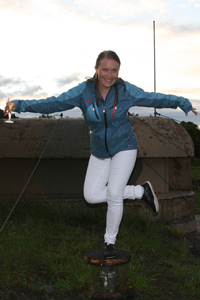The Antarctic Peninsula
One early morning we entered the Lemaire Channel. We had received the news that the channel was jammed by ice and the captain wasn't sure if we would manage to sail through. The captain did a good job and we zig-zagged between the ice sheets and managed to get through. Then we reached the southernmost point on our trip at 65 degrees south, before we turned around and started our journey back towards the civilisation. In the narrow channel we spotted a group of killer whales. So cool!




Later during that day we visited the British research station Port Lockroy located on a small island. They have both a museum and a souvenir shop! On the small island hundreds of gentoo penguins walked around. We also had a little walk on the sea ice where we met a weddel seal with a cub.













Next morning we landed at the real Antarctic peninsula close to Orne Harbour. Earlier we had only landed at different islands. Here I built a snow penguin and he turned out to be a very picture among other expedition members. :-)





Our expedition leader Martin Enckell in the snowstorm. Smiling as always!
Our Antarctic adventure ended with a zodiac-cruise close to Melchoire Islands. Here we spotted some chinstrap penguins and a seal.




A fantastic journey came to an end when Ocean Nova was heading back towards the Drakes Passage. Two days later we were back in Argentina. This was an unbelievable journey from the beginning to the end. A dream came true! Thank you PolarQuest for this adventure! :-)

The food onboard Ocean Nova was very good! Here is a swan dessert.

Drakes Passage is not always as calm as this!
South Shetland Islands
On our way towards the South Shetland Islands we passed a couple of beautiful icebergs. Some of the icebergs are flat on top and they are called table icebergs.


We were also lucky to spot whales. The first whale that we saw was a blue whale! The world's largest mammal! They are quite rare so it's not often that you are lucky to see one. Unfortunately I didn't manage to catch it with my camera, but I'm so happy over the fact that I've seen one! We also had a group of minke whales swimming along with us for a while.




(Map from Wikipedia)
Our next destination was the mountainous and barren Elefant Island and Point Wild, which is the name of the beach where Shackleton's men managed to survive under two lifeboats, turned upside down, when they waited for rescue. On the beach you can find a staty of Luis Pardo, the captain of the ship Yelcho who later saved the men from the death. Nowadays the island is inhabited by hundreds of chinstap penguins.






We landed in Whaler's Bay, which was the largest whaling station in Antarctica during its' high days. Here we met two crabeater seals on the beach.











